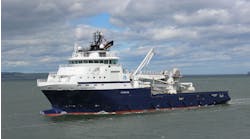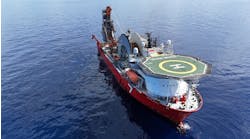Jeremy Beckman, Editor, Europe
Two major offshore projects to begin
The Gorgon project, Australia’s largest and potentially most complex gas field development, took a big step forward this summer with the award of two major engineering contracts. A jointventure of Technip Oceania and JP Kenny (Perth) was appointed to handle front-end engineering design and engineering, procurement, construction, and management of all subsea facilities and pipelines required to transport the gas to Barrow Island.
Chevron Australia is operating the $11-billion development as 50% equity holder, in partnership with the Australian subsidiaries of ExxonMobil and Shell (25% each). The project will in time encompass numerous gas fields located between 70 and 140 km west of Dampier on the mainland, and around 60-km from Barrow Island.
Gorgon, discovered in 1980, is the second largest of the fields with 13 tcf of proven reserves. Including the most recent addition, Jansz, a giant deepwater discovery, the project’s estimated collective resource is around 40 tcf.
Under the planned first development phase, subsea wells drilled on Gorgon (200 m water depth) and Jansz will be tied back via two submarine pipelines directly to a new two-train, 10 million ton/yr LNG plant on Barrow Island. Front-end engineering design for the downstream aspects is being handled by the Kellogg/Clough Joint Venture.
According to Steve Wayman, chief executive officer of JP Kenny Group, based near London, the planned export volumes will necessitate two trunklines of probably 30 in. diameter. The pipeline from Gorgon will need to withstand up to 15% CO2 in the Gorgon gas, with an exiting wellhead temperature of around 130° C. The team has yet to determine the line pipe material, with the base case being internal cladding with a corrosion-resistant alloy. As Jansz has a much smaller CO2 content, its 180-km 30-in. pipeline will be made from regular carbon steel.
“Cyclone activity is also a major issue in this part of the world,” Wayman points out. “Cyclones have been known to cause movement of seabed pipelines on the North West Shelf. During the design phase, therefore, we will be paying a great deal of attention to the stabilization regime, looking at combinations of rock-dumping and gravity anchoring. Barrow Island is also a Class A nature reserve and the Gorgon Project will incorporate high standards of environmental management into the design, construction, and operation so that the island’s important natural values are protected. For example, the pipeline-shore approach will likely be tailored to minimize impact to local flora and fauna.”
Another potential challenge is the planned 180-km subsea umbilical from Barrow Island to the Jansz subsea manifold. Although long-distance tiebacks are becoming more common in the Gulf of Mexico and Northwest Europe, this length will be a world first.
Almost all upstream FEED work for the project will be performed in Western Australia, and should be completed by mid-2006. The partners will then move on to detailed design and procurement of long-lead items such as line pipe, subsea trees and umbilicals.
Woodside inventory
Elsewhere off Western Australia, JP Kenny’s Perth office has been working on other subsea projects for Woodside Petroleum, including the Angel gas-condensate development. The program involves three large bore, high output subsea wells exporting the wellstream to a new central processing platform, plus pipelines and five subsea structures. From the platform, the gas will be sent 50 km to the North Rankin installation via a 30-in.trunkline, tying into the export pipeline via a subsea tee. The latter will be pre-installed this May, during a planned shutdown of North Rankin, by means of a hot-tap operation.
JP Kenny also performed FEED work on Woodside’s Enfield development, mainly relating to the subsea well tiebacks in 500 m of water to the 900,000-bbl storage capacity FPSO. The company is also handling engineering for a four-well large-bore subsea tieback from the Perseus Over Goodwyn field to the Goodwyn complex, via a 23-km, 16-in., corrosion-resistant alloy pipeline.
Pipelay activity is on the rise across the Asia-Pacific region, due mainly to relentlessly growing gas/LNG demand. JP Kenny in Perth recently completed detailed engineering for the newest trunkline project in Thailand’s energy “master plan,” under sub-contract to Hyundai. The scheme involves installing 600-km of 42-in. pipeline to take gas from the Arthit fields offshore western Thailand to the eastern seaboard.
The offshore section will extend 173 km from the new PRP platform serving Arthit, before veering a further 414 km to Rayong on the west coast. The pipelay exercise should be routine, according to Wayman, as conditions in the Gulf of Thailand are normally benign. Water depths along the route are between 60 and 80 m. JP Kenny’s scope included the design of 11 tie-in points (tees, pipeline end manifolds, and hot taps) to accommodate future supplies from other fields along the route.
Farther south in the Gulf of Thailand, JP Kenny is undertaking project management services for Vietsovpetro for the proposed 300-km PM3 pipeline taking gas from the
Bunga Raya platform to a combined power/fertilizer plant near Ca Mau in southern Vietnam. JPK also handled FEED for the offshore pipelines for BP’s current Tangguh LNG project on Irian Jaya, Indonesia.
Although these lines are only 16-23-km long, engineering was complicated by the gas properties and the environmental conditions. The gas is high temperature, necessitating use of a 316L clad corrosion-resistant alloy material for the pipe; along the route, there are locally strong bottom currents and tidal currents in the Birds Head area close to the landfall.
“The seabed itself is difficult,” Wayman adds, “comprising the worst possible combination of soft mud and very hard rock.” JP Kenny has since been appointed to supervise project management of construction operations.
“HT/HP gas development is growing generally in this region, as elsewhere in the world, as oil companies exploit deeper and deeper reservoirs,” Wayman adds. “We recently began a project for Shell off Malaysia for two small fields, G7 and M3S, each calling for a one-well subsea tieback to the M3DRA platform in block M3, in 120 m of water. The multiphase fluids are 110-140° C and 225-310 barg, which again means using an internally cladded pipe in a corrosion-resistant alloy. And bearing in mind the gas composition, the tieback distances - 10 and 25 km - are not exactly trivial.”
JP Kenny Malaysia has also supported Shell Sarawak in the engineering of various other HT/HP pipelines with design temperatures of up to 135° C. One task involved devising remedial action to prevent lateral buckling, should the pipe become embedded in the soft silty clay along the route. Conventional bundle mitigation methods, such as positioning the pipe via burial and gravel dumping, are not practical in this region due to limited availability of suitable materials and equipment.
The study in this case led to the selection of a new concept that involves deploying a series of vertical sleepers or “triggers.” These ensure the pipe is raised clear of the seabed at pre-determined locations, and is therefore free to buckle in a controlled way. According to JP Kenny, the system can be fabricated from spare pipe joints or from cast concrete and installed directly from the pipelay vessel, just ahead of the pipeline touchdown point. The system is currently being applied on the E8 28-in, 42-km pipeline.•




